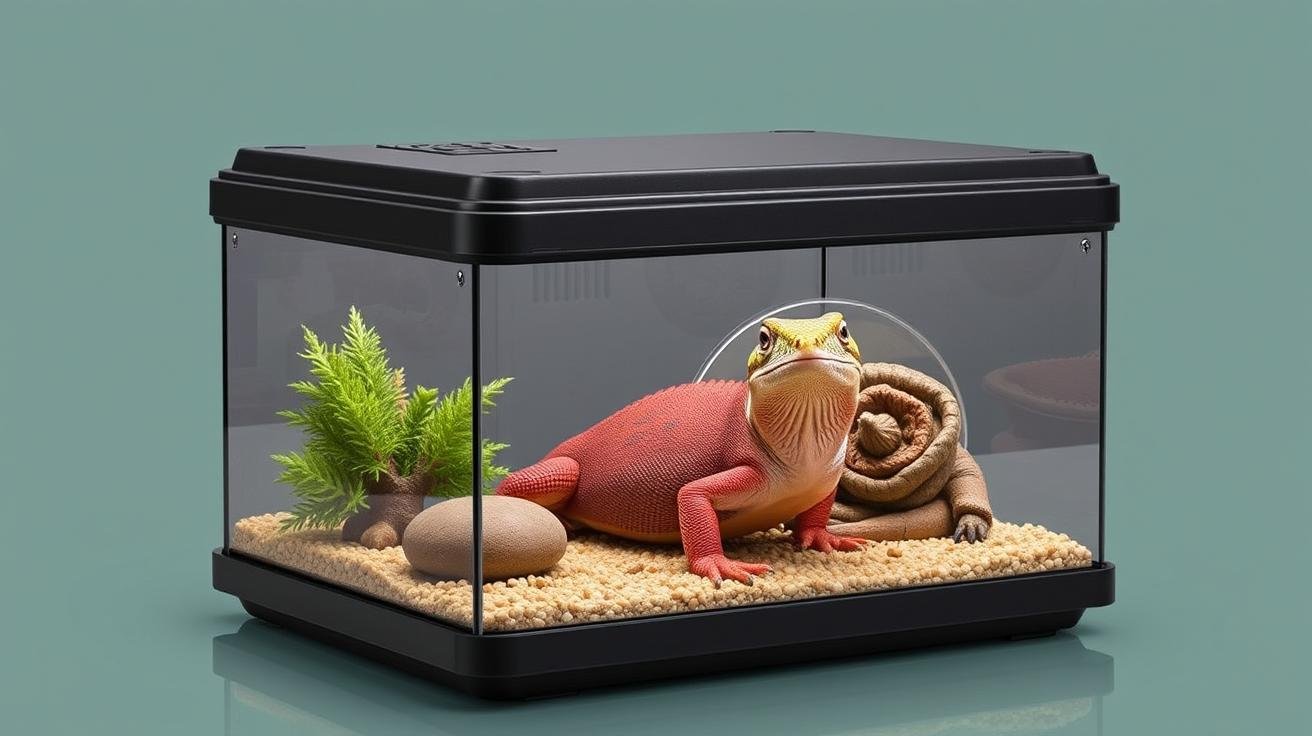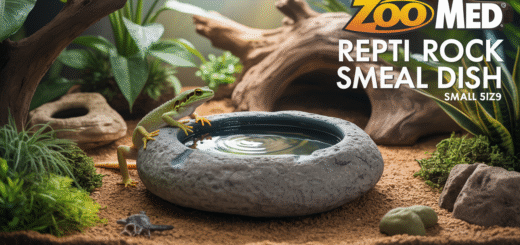Exo Terra Faunarium Review: A Reptile Keeper’s Must-Have

Estimated Reading Time: 8 minutes
Exo Terra Faunarium Review: The Unsung Hero of My Reptile Room
In the world of reptile and amphibian keeping, we often get excited about the big-ticket items—the elaborate vivariums, the high-tech lighting systems, and the fancy misting setups. But sometimes, it’s the simplest, most unassuming pieces of gear that become the true workhorses. Let’s be honest, we all need a reliable, no-fuss container for a million different tasks. Whether you’re bringing home a new pet, heading to the vet, or setting up a temporary quarantine space, you need something dependable. Today, we’re taking a close look at one of those essential items: the Exo Terra Faunarium (Flat Home, Large). It might not look like much, but as I’ve discovered over years of use, its utility is hard to overstate.
Key Takeaways at a Glance
- Incredibly Versatile: The Faunarium excels as a transport carrier, a temporary enclosure for quarantine or observation, and a holding container for feeder insects.
- User-Friendly Design: Features like the transparent access door, secure snap-lock lid, and excellent ventilation make it practical for both the keeper and the animal.
- Easy Maintenance: The simple, smooth plastic construction is a breeze to clean and disinfect, which is critical for maintaining animal health, especially during quarantine.
- Space-Saving: Its stackable design is a huge plus for breeders or anyone with multiple animals, helping to keep reptile rooms organized.
Our Final Call: The Reviewer’s Take
Let me cut to the chase. If you keep any kind of small reptile, amphibian, or invertebrate, you should have at least one Exo Terra Faunarium on hand. Period. It’s one of those products that you don’t realize you need until you suddenly *really* need it. I’ve used mine to transport a nervous new leopard gecko home from a reptile expo, to house a dubia roach colony, and to temporarily separate a picky eater for a supervised feeding. Its straightforward, functional design is its greatest strength. It’s not a permanent home for most species, and it’s not meant to be. Instead, it’s the ultimate utility player—an essential piece of pet supply that solves a dozen common problems for herpetoculturists. For its low price point, the peace of mind and convenience it offers are invaluable.
Deep Dive: Essential Features & Benefits
What makes this simple plastic box so useful? It’s all in the details. Exo Terra clearly designed this with keepers in mind, focusing on the small things that make a big difference in our day-to-day husbandry tasks.
1. The Ideal Transport & Temporary Home
The primary function of the Faunarium is right in its name: it’s a temporary home. Its lightweight yet sturdy construction makes it a go-to for transporting animals. It’s far safer and more secure than a cardboard box. The well-ventilated lid ensures your pet gets proper airflow during transit, reducing stress. I find the Large Flat Home version particularly good for this, as its lower profile prevents smaller, ground-dwelling animals like geckos or frogs from being jostled around too much.
2. Smart Access & Secure Lid
One feature I particularly appreciate is the small, transparent hinged door built into the main lid. This is a game-changer. Instead of having to remove the entire top to offer food or water—which can be a huge escape risk with flighty animals—you can just pop open this little door. It minimizes disturbance and stress for the animal. The main lid itself snaps on firmly, providing a secure closure that would be difficult for most small critters to challenge. It gives you confidence that your pet is safe inside.
3. Effortless Cleaning & Disinfection
If you’re using this for quarantine (and you should be!), ease of cleaning is paramount. The Faunarium’s smooth, non-porous plastic surfaces have no tricky corners or crevices where bacteria can hide. It can be quickly wiped down, washed with soap and water, and disinfected with a vet-grade cleaner like F10 or a simple diluted bleach solution. This makes it an incredibly effective tool for isolating new animals and preventing the spread of potential pathogens to your established collection.
4. Stackable & Organized Storage
For those of us with limited space (which is pretty much everyone in the hobby), the stackable design is a lifesaver. The lids have molded grooves that allow another Faunarium to sit securely on top. This is fantastic for breeders who need to house multiple hatchlings separately or for anyone keeping different types of feeder insects. It turns a potential pile of containers into a neat, organized tower, which is a big win for any reptile room.
Who is the Exo Terra Faunarium For?
This product serves a surprisingly wide range of keepers. Let’s see who benefits most:
- The New Reptile/Amphibian Owner: When you bring your first pet home, you need a safe way to transport it. This is perfect. It will also serve you for years to come for vet visits or temporary housing during a deep clean of the main enclosure. It’s a foundational piece of essential gear.
- The Experienced Breeder: Breeders often need to house numerous hatchlings, sort males and females, or transport animals to shows. The Faunarium’s stackability, security, and ease of cleaning make it an indispensable tool for managing a large collection efficiently.
- The Invertebrate Keeper: For those who keep tarantulas, scorpions, or insects, the Faunarium is an excellent and affordable housing option, especially for terrestrial species that don’t require deep substrate. It provides great visibility and ventilation.
- Anyone Who Uses Live Feeders: Tired of crickets escaping their flimsy cardboard box? A Faunarium is the perfect, escape-proof home for feeder insects like dubia roaches, crickets, or mealworms. The easy-access door makes grabbing a few for feeding time a simple task.
Real-Life Use Cases: Where It Shines
To give you a better idea, here are a few scenarios where my Faunarium has been a total lifesaver:
- Quarantine Central: I recently acquired a new crested gecko. It spent its first 30 days in a Faunarium lined with paper towels, a small plant, and a water dish. This sterile, simple setup allowed me to easily monitor its health, feces, and appetite before introducing it to a fully bioactive setup.
- The Vet Trip: My bearded dragon needed a check-up. Instead of wrestling with a bulky enclosure, I placed her in the Large Faunarium with a paper towel. It was easy to carry, fit perfectly on the car seat, and the vet could easily see her through the clear plastic before even opening it.
- The Feeder Roach Palace: My dubia roach colony lives happily in a stack of these. They are easy to clean, the ventilation prevents mold, and the secure lid keeps the fast-moving roaches contained. It’s a far better solution than the generic plastic tubs you might find at a hardware store.
The Good and The Not-So-Good
Pros / Highlights
- Excellent ventilation on the lid promotes healthy air circulation.
- Crystal-clear plastic offers an unobstructed view of the animal.
- The snap-on lid is very secure for its class.
- Lightweight and easy to carry.
- The integrated small feeding door is a fantastic, practical feature.
- Very affordable, making it accessible for any budget.
Potential Drawbacks / Cons
- The plastic can scratch over time, especially with active animals or abrasive substrates.
- Not suitable for long-term housing for most reptile species due to its size and inability to hold heat gradients well.
- Stronger animals, like a determined juvenile snake, might be able to test the lid’s security. It’s best for small or less powerful species.
Frequently Asked Questions (FAQ)
1. Can I use the Exo Terra Faunarium as a permanent enclosure?
For most reptiles and amphibians, the answer is no. It’s too small to provide adequate space and a proper temperature gradient. However, it can be a suitable permanent home for some invertebrates like tarantulas, scorpions, or small insect species.
2. How secure is the lid? Could a snake escape?
The lid snaps on quite securely and is great for most small lizards, geckos, frogs, and insects. For a notoriously skilled escape artist like a small corn snake, I would add extra security, like binder clips or a strap, just for peace of mind during transport.
3. Can I use a heat mat with the Faunarium?
Yes, you can. You can place a small, thermostat-controlled heat mat under one side of the Faunarium. It’s crucial to use a thermostat to prevent the plastic from overheating or melting and to ensure the animal’s safety. Never use a heat mat without a thermostat.
4. What is the difference between the ‘Flat Home’ and the regular Faunarium?
The ‘Flat Home’ version, like the one reviewed here, has a lower vertical profile. It provides more floor space relative to its height, making it ideal for terrestrial (ground-dwelling) species. The regular or taller versions are better suited for smaller arboreal (tree-dwelling) species or for housing feeder insects like crickets that benefit from more vertical space.
Final Thoughts
The Exo Terra Faunarium isn’t flashy, but it is fundamentally a well-designed, practical, and safe tool that solves real problems for animal keepers. It’s a multipurpose container that you’ll find yourself reaching for again and again. For its combination of security, visibility, and ease of maintenance, it provides tremendous value. If your reptile care toolkit doesn’t include one of these, it’s a small investment that will pay off in convenience and safety for years to come. It’s a must-have for reptiles and amphibians keepers, from the beginner to the seasoned expert.



